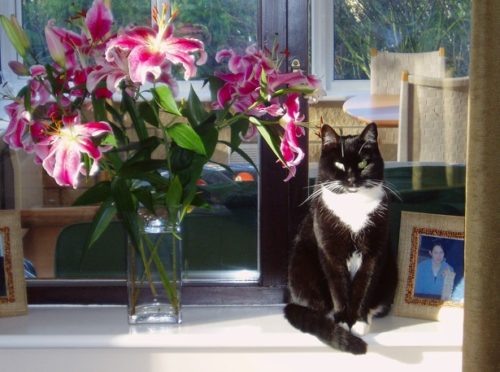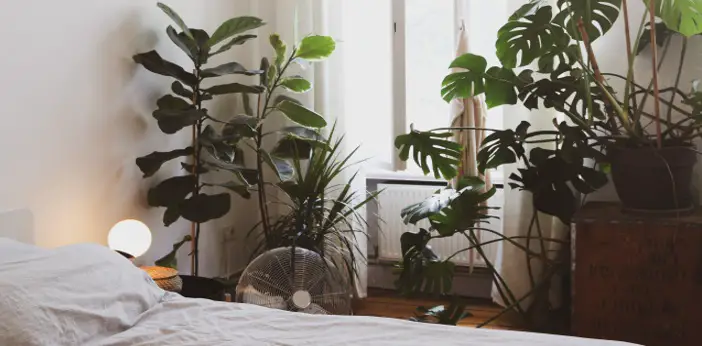Flowers and plants are a wonderful way to spruce up our homes and fill them with the scent of nature. There is, however, a note of caution that pet owners should be aware of.
Unfortunately, the exploration of new sights, smells, and tastes by our canine and feline companions can get them into all sorts of scrapes.
This is of particular significance when it comes to flowers, as some species can be toxic to animals if swallowed.
As pet owners, we need to be aware of which flowers are harmless to our animals and which might do them great harm.
Some plants, if swallowed, may simply produce moderate digestive discomfort, while other plants may bring significant repercussions such as liver failure, breathing difficulties, or even death.
This is why constant vigilance and making sure these potentially harmful plants are out of reach of pets is so important. Then, what kinds of plants and flowers should we be wary of?
Household favorites like lilies, tulips, daffodils, and hyacinths are among the plants that could be harmful to humans if ingested.
Because of the toxic substances these plants produce, they can induce a wide range of symptoms, from gastrointestinal distress to more severe conditions.
Peace lilies, caladiums, and dieffenbachias are just a few examples of plants that can cause skin irritation, swelling, and even temporary blindness due to their irritating chemicals.
In addition to flowers, many other plants can be harmful to pets. Ferns, ivies, and several succulents, among others, can cause major health concerns if consumed.
To the contrary, some of these plants have unpleasant sap that can cause skin and eye irritation, while others have toxic compounds that can cause major digestive disorders.
So, how can you keep your pet safe from these potentially lethal plants? The greatest method to ensure the safety of your pet is to get rid of any houseplants that could be harmful to them.
You should ask a vet or expert botanist if a certain plant is safe for pets if you have any doubts.
There are also a variety of plants that are safe for pets to be around, such as African violets, spider plants, and herbs like basil and rosemary.
Table of Contents
Pet-Friendly Flowers For Cats And Dogs
Every one of us who has a pet shares a desire to provide a secure and cheerful home for our four-legged family members. Flowers are a great way to liven up a space and bring some of nature indoors, but some species can be toxic to pets.
In order to keep our feline and canine pals safe, it is necessary to know which flower kinds are poisonous to them.
However, it’s still advisable to keep flowers and foliage out of their path as much as possible because, just like us, our pets can have allergies and particular needs.
If you want to bring flowers inside your home, however, there are several species that pose less of a threat to your cat or dog.
The following is a list of flowers that are safe to have in your home with cats and dogs:
1. Freesia – These springtime beauties are a great addition to your coffee table or windowsill.
2. Gerbera daisies – These vibrant and cheery blooms are a hit among pet owners.
3. Limonium – The pastel-hued flowers of limonium are a great alternative to gypsophila.
4. Lisianthus – These delicate and beautiful blooms symbolize appreciation and gratitude.
5. Pitto – This leafy foliage is usually featured in cascading wedding bouquets, but it’s safe for pets.
6. Roses – A timeless classic that’s both safe for pets and a symbol of romance.
7. Snapdragons – Although you should still keep these blooms out of the way, they pose a lower risk than other flowers.
8. Statice – These fluffy purple blooms are a great addition to any bouquet.
9. Stock – These rustic blooms are safe for pets and perfect for creating a cottage garden vibe.
10. Sunflowers – This cheerful late summer bloomer is also a great source of food for both humans and pets.
11. Waxflower – These long-lasting blooms can stick around for up to 10 days, making them a great addition to any bouquet.
While there are some flowers that are definitely not suitable for our pets, there are other several that are much less dangerous. If you have any furry pets, keep a watch on them and teach them to avoid the floral arrangements. Here is a list of flowers that are safe for both cats and dogs, so you can bring more of nature into your house.
How To Keep Pets Safe From House Plants
Plant-lovers, hear the good news! If you have a pet or two, you don’t have to give up your green thumb simply because you have cats or dogs.
There are numerous plants and flowers that are toxic to pets, but there are also plenty that are perfectly fine for them to eat.
There is a wide variety of pet-safe flowers available, from cheerful sunflowers to graceful lisianthus. However, keep in mind that just like us, our pets may have certain requirements and even allergies.
Despite the fact that these blooms have received a relatively clean safety bill of health, you should still keep them well out of reach.
However, there are several easy measures you may take to save your plants and animals. What follows is a list of suggestions:
Choosing Pet-Safe Flowers
Flowers that are poisonous to pets should be avoided at all costs, so it’s crucial to do your homework before bringing any home.
Flowers such as sunflowers, daisies, and snapdragons are all suitable for pets. These blossoms provide no danger to humans or animals, so everyone can enjoy them.
Though not all flowers are created equal, and some may be more dangerous than others, it is still crucial to do your homework before picking any flowers.
Flowering plants like lilies, for instance, can be harmful to cats if they ingest even a small amount of their pollen. It’s best to avoid lilies and go with alternatives that are safe for cats if you have a house full of them.
Flowers like daffodils, foxgloves, and oleander are harmful to animals and should be avoided. Keep these flowers out of your pets’ reach, as they can cause major health issues if swallowed.
Pet-safe flowers allow you to bring the beauty of nature into your house without worrying about the well-being of your pets.
Keeping Flowers Out of Reach
If you have pets, it’s best to keep any flowers that aren’t pet-safe well out of reach. Cats and other pets that like to nibble on plants really need to be reminded of this. Flowers can be protected from pets in a number of ways.
The flowers could be stored on top shelves or in another area that pets can’t easily get. Inquisitive animals won’t be able to come close enough to the flowers to eat them this way.
It is also possible to use fences or other physical obstacles to keep pets from destroying your flower garden.
To prevent your pets from destroying your flowers, you should keep them in a room they are not allowed in or secure them in a space with a baby gate.
Keep a watch on your pets whenever they are near any kind of flower, just in case. You may avoid any unintentional consumption and discover any problems early with this method.
You can assist your pets to remain safe around live flowers in the house by placing them out of reach and keeping a close eye on them at all times.
Monitoring Your Pets Around Flowers
It’s crucial to keep an eye on your pets while they’re near flowers. If you have pets, it is best to keep a close eye on them even if a particular flower is thought to be safe for them.
You may avoid any unintentional consumption and discover any problems early with this method.
Pets should be kept under close observation whenever they are around blooming plants. A simple solution is to always keep an eye on your pets whenever they are around any kind of flower.
If you have cats or other pets who like to nibble on plants, this advice may be especially useful. If you keep an eye on your pets, you can see any issues early on and stop any unintentional ingestions.
Fences and other physical obstructions can also be used to keep pets out of the flower garden. To prevent your pets from destroying your flowers, you should keep them in a room they are not allowed in or secure them in a space with a baby gate.
You may have beautiful live flowers in your home without worrying about harming your dogs if you take the necessary precautions.
Providing Alternative Plants For Pets
Plants like catnip, wheatgrass, and alfalfa are all fine for pets to nibble on. These plants can serve as both a natural distraction for your pet and a deterrent to them exploring potentially toxic blossoms.
You may prevent your pets from ingesting toxic flowers by a variety of means, including giving them with safe alternative plants to chew on. If you don’t want your pets destroying your floral arrangements, there are a few things you can do.
Enjoy the beauty of real flowers without worrying about the well-being of your pets by giving them with safe alternatives and taking other precautions.
Create Physical Barriers
Putting up physical barriers is a quick and easy technique to prevent your pets from destroying your garden. If your pet has a history of destruction or of getting into things, this technique will be extremely helpful.
You can effectively construct a physical boundary with screens or fences. You may prevent your pets from eating your plants and flowers by enclosing them in screens or fences.
If you have plants outside and need to keep them safe, this is the best option. To protect your plants and flowers from animals and the elements, you can build a garden fence, a trellis, or a planter box with a top.
Your other option is to keep your plant and flower arrangements in areas of the house that your pets rarely or never enter. If you don’t want your dogs in the bedroom, for instance, that doesn’t mean you can’t decorate it with plants and flowers.
Your dogs will be kept safe and you may relax among your plants and flowers. Plants and flowers can also be kept in places that are out of reach of pets, including on top of a high cabinet or counter.
Train The Pets To Leave Plants Alone
A beautiful and pet-friendly home may be maintained by teaching your pets to respect your houseplants. Patience and perseverance are called for, but the results can be rewarding in the form of a peaceful home life for everyone.
The first step is to distract your pet from the plants with something more interesting, like a toy or a reward.
Provide positive reinforcement by praising or petting them when they do as you ask; for example, give them a special food or toy every time they avoid the plants.
As time goes on, your pets will learn that the plants are associated with good things and won’t bother them as much.
Not all pets are the same, and some may be more inquisitive or naughty than others. Younger pets, such as kittens and puppies, are more likely to get into trouble and chew on plants.
To help your pet develop appropriate behavior around your plants, you may need to be more watchful and give them more structure and instruction in certain situations.
Seeking Veterinary Care If Necessary
If your pet accidentally eats a deadly flower, you should take them to the vet right away. The veterinarian can assess the problem and administer the appropriate care.
It’s important to note that the signs of flower toxicity in animals might change based on the specific bloom and the amount taken.
Lethargy, trouble breathing, nausea, and diarrhea are just few of the common symptoms. See a vet immediately if you observe any of these signs in your pet.
The vet can assess the condition and provide the appropriate care. It may involve giving medication to alleviate discomfort, induce vomiting, or both.
Some situations may require medical attention at a hospital.
Remember that the sooner you take your pet to the vet, the greater its chance of making a full recovery.
Acting swiftly and, if required, consulting a veterinarian can increase the odds that your pet will receive lifesaving care and make a full recovery.
It can be very upsetting for people who have a soft spot in their hearts for flora and fauna to consider the possibility of having to keep their beloved plants and flowers safe from the prying eyes of pets.
The idea that one would have to make a decision between having a lush, beautiful home and having a furry pet to share it with seems unjust.
But what if we informed you that going forward, you won’t be required to make that decision? We have outlined some pet friendly flowers you can keep in your house and be comfortable with them.
You may have the best of both worlds if you put in a little bit of work and ingenuity and build a harmonious environment where your lovely flower arrangements and loyal companions can cohabit without the fear of broken vases and spilt pots. This is the greatest of both worlds.


